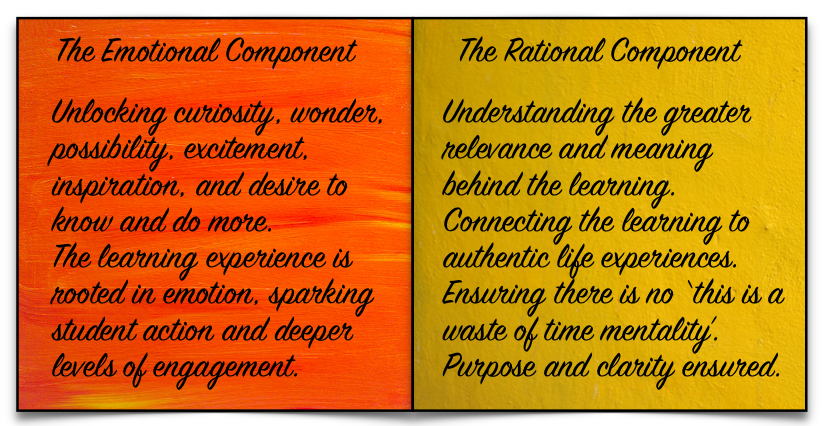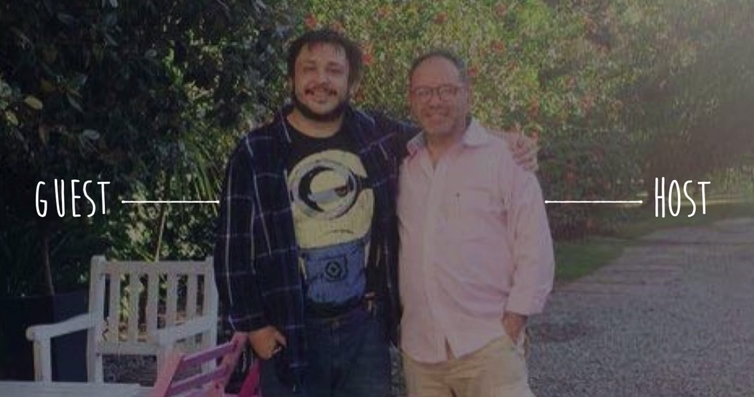Does your teaching build or stifle emotional momentum?I recently recorded a podcast in my #RunYourLife series with John Rinker, a very insightful and knowledgeable design teacher at Nanjing International School in China. John and I have had in-depth discussions many times in the past about the role of design thinking in education and the profound impact that it can have on student learning. In short, design thinking is all about improving the quality of peoples' lives and bringing about a better life experience both in and out of school. Often times there is a big misconception when it comes to design thinking in that many people believe it is all about creating an actual final product such as a table, chair, birdhouse, or other types of things. However, in reality, design thinking is all about the process of improving upon our lives by identifying problems and creating solutions through a certain cycle of innovative learning. To listen to John and I discuss the role of design thinking in teaching and learning, please click this link: http://21clradio.com/designing-way-good-life-run-life-18/ The focus of my blog post today is to deconstruct what it takes to create more emotional momentum in our teaching and in student learning. To emphasize this theme, I want to begin by sharing a great story from a recent Ted Talk I listened to given by Tony Fadell, a Lebanese-American inventor, engineer, presenter, and speaker who is responsible for creating one of the first versions of the iPod. In his Ted Talk, Tony discusses the need to create better solutions to life's real problems in an effort to bring about a more meaningful experience in peoples' lives. He delves into his own experience in designing the iPod and the depth of thinking that went into creating this product. Tony also discusses the critical importance of creating emotional momentum when it comes to customers wanting to use new products. The concept of 'emotional momentum' does not only apply to buying and using new products only, but is widely applicable across a multitude of experiences in our lives. Having underlying 'emotional momentum' in our lives greatly powers our learning forward and instills within us a greater sense of meaning and purpose. However, there are obstacles and frustrations that can stifle emotional momentum bringing it to a complete halt. In his Ted Talk, Tony gives a specific example of how this used to happen with Apple products years ago. Steve Jobs recognized early on in the design process that there was a massive 'emotional momentum' crusher working against the company when it came to all of their products. He couldn't tolerate it and demanded that the problem be resolved in order to encourage and strengthen the emotional momentum created when Apple customers first got home after buying their products. According to Jobs, he hated the fact that his customers were so excited to use their new purchase only to find out that they had to charge it for hours before actually being able to use it. He demanded that the problem be resolved and set his team of designers the task of ensuring this never happened again to any Apple customer. There would be no more 'CHARGE BEFORE USE' with any Apple product. Hence, Apple was the first company to have all of their devices fully charged and ready to go upon opening up the box after purchasing the product and many companies followed suit soon after. Tony Fadell uses this story to illustrate a very important point. The human experience must always be about creating positive emotional momentum, therefore removing brick walls and other forms of obstacles to this momentum must be of critical importance regardless of what it is we are trying to accomplish in life. Whether it be creating and building a new product, constructing new habits in our lives, changing our mindsets, or finding a love and passion for music, art, sport, or reading, THERE MUST be a strong component of emotional momentum fuelling us forward in any of our pursuits in life. There is no greater place for building, sustaining, and deepening emotional momentum than in our schools. The research clearly shows that when students are emotionally invested, learning takes on much more significance and meaning. I would present a strong case that teaching motivation is directly affected by levels of emotional momentum in action in their lives as well. When looking at creating a stronger sense of emotional momentum, Tony Fadell states that two critical components must be a part of everything that happens in the design process. Without question the same principles apply to both teaching and learning as well when it comes to creating more emotional momentum in our schools. Many of these things already seem so obvious to good educators, but I would argue that not enough time and energy is invested in creating more emotional momentum in our schools. In saying this, I am not only referring to student learning, teacher motivation and well-being carry equal significance in this process. It's not possible to always have our batteries fully charged and ready to go. I get this! I really do. However, creating more emotional momentum in both teaching and learning is an investment well worth the time and effort. Thanks for reading. Click on the link below to hear Tony Fadell's excellent Ted Talk.
2 Comments
Addressing Levels of Trust at a Deeper LevelIn his 2016 Ted Talk, Air B & B founder, Joe Gebbia, discusses the main reasons for the success he had in launching Air B & B to legendary status in the business world in just a few short years. Although he and his partners fell flat on their face back in 2008 when first trying to pitch their idea to investors in Sillicon Valley, that experience itself helped them to understand that they had to challenge the predominant belief system that people held when it came to trusting others. Air B & B bases itself upon trust as customers using their service have to open their doors to complete strangers wanting to stay in their houses or apartments. The biggest obstacle that Jeff Gebbia and his team faced when trying to launch their company was to tackle trust issues that people had when it came to the idea of letting complete strangers stay in their homes. Conversely, the customers about to stay in people's homes also needed to feel a strong element of trust as well. After all, they are entering another person's home and obviously want to feel comfortable and safe. To address this issue, Gebbia and his team designed a system that helped to build a solid foundation of trust in every interaction that takes place between home owner and customer. You would think that out of 123 million transactions to date, there would be some serious breeches of trust. However, as Gebbia explains, they have had serious trust issues in less than 1% of all interactions. Obviously, whatever it is they have done to promote and build trust has worked fabulously for them. To Gebbia and his team at Air B & B, the driving force behind their thriving business is all about planting the seeds of human connection. What they do and what they are all about stems directly from their profound belief that there must be a human connection beyond each transaction itself. He proudly shares a touching story that exemplifies this fundamental philosophy that Air B & B holds in relation to the importance of the human connection. There was an American guest who had used Air B & B to book a few nights at a house in Uruguay. You can imagine the fear that Javier and Oliandra, the Uruguayan owners of the house felt when their guest suffered a heart attack while staying at their place. The guest nearly died but underwent bypass surgery and ended up surviving (Javier and Oliandra even donated their own blood that was used in the surgery). During his Ted Talk, Gebbia shares the review that the guest left on the Air B & B website regarding his stay at Javier and Oliandra's place: Although the review was light-hearted and comical, when we probe deeper we see the bigger picture of what this one example represents. The element of human connection beyond the transaction is based upon the core building blocks of trust, respect, empathy, compassion, and bringing a deeply caring mentality to everything that we do in our personal and professional lives. I believe that this story serves as a powerful metaphor for what great teaching is all about. Teaching is not just a job, but something much more powerful that must be rooted in sharing an important part of ourselves with the promise of a meaningful human connection that goes well beyond the transaction of teaching and learning itself. How do you address levels of trust in your teaching environment? In what ways do you design and engineer this environment to be a constant reminder that trust is expected, modelled, and a part of the very fabric of every interaction taking place between the students themselves and between teacher and students? What kind of teacher reviews do you want your students to one day write for you? Not now, but years down the road when they reflect upon the experiences that they had while under your care? Is teaching a mere transaction or do you strive to embed deep and meaningful human connections in all the interactions you have with your learners. I know many of you reading this blog post care deeply about what you do but it's always good to be reminded about what it takes to make a difference and to be the very best educators that you can be. To check out Joe Gebbia's Ted Talk, please click on the video below. Thanks for reading folks! Asking ourselves those tough questionsWhether we like to admit it or not, there is no question that we all hold certain biases about the world around us and people in general. At times, we may be aware of these biases but continue to hold on to the beliefs that we have because it helps us to make better sense of our lives and our place in the world. More often than not, the biases that we hold are at the subconscious level, therefore it is extremely difficult to be self-aware of what these biases are. It’s only through genuine reflection and asking ourselves tough questions that we can begin to better understand these biases and the role that they play in our lives and our teaching. As educators, our teaching can be negatively impacted by certain biases that we hold making it our professional responsibility to invest the time in trying to uncover what these biases are in an effort to better understand and deconstruct why it is we think in certain ways. It is imperative to challenge these beliefs and in doing so, I believe that we put ourselves in a much better position to change the ways that we teach which will no doubt have a lasting impact on student learning. I recently came across an excellent Ted Talk given by Verna Myers, a Harvard-trained lawyer, entrepreneur, author and cultural innovator. She has devoted her life to working with different firms and organizations helping people to better understand biases that they hold in an effort to increase workplace morale, productivity, and overall sense of togetherness. In her Ted Talk, Verna shares that she often comes across people who genuinely believe that they do not have a bias bone in their body. She likes to challenge these beliefs straight away and does so by sharing her own story of personal bias. Verna explains to the audience that she was once aboard a plane ready to take off when she heard the voice of the head pilot making an announcement. The head pilot was a woman and Verna’s immediate internal response was “YES! Woman power!”. She went on to say how great she thought it was that a woman was in charge of this massive plane and responsible for the rest of her crew and all the passengers.
A couple of hours into the flight, they began to fly through some severe turbulence. She realized at this point that she was thinking to herself that this 'woman better know how to fly in such extreme conditions' and began to doubt her piloting skills. Her default setting was to doubt the woman’s ability to fly the plane in severe conditions. You can imagine how bad Verna felt having confronted the fact that she had just uncovered an injust personal bias that she had held. Here she is a consultant travelling the world working with firms and organizations to help them uncover biases that they hold while all along she still held a damaging, personal bias of her own. Despite believing in her heart that women deserve equal treatment and access to the same professional opportunities as men, she realized that at a subconscious level, she held this negative stereotype about women. As I continue to consult and work with lots of different teachers in various regions of the world, I have the chance to observe many of these educators in action in their own programs. I’ve been lucky to see some great teaching and really meaningful, relevant learning happening in their programs. However, I like to always remind teachers about the need to be very aware of the belief systems that we bring with us into our teaching. Through high school and university, I was a competitive athlete having excelled in both golf and football. I generally picked up sports very quickly and had a lot of confidence when it came to playing sport both competitively and recreationally. However, when I first started teaching PE, I had a major skill and drill type of coaching mentality and because I had learned sport quickly myself, I had a belief system in place that all people should be able to learn skills easily if they narrow their focus and concentrate. To be honest, I didn’t have a lot of patience or understanding when students struggled. As a competitive athlete, I had a certain attitude that I brought with me into my teaching that I was not aware of. It was only a few years into my teaching, when I really began to question what it was I was doing and why I was instructing the way that I was. In my observations of teachers over the past several years, I have seen this same mistake or personal bias come into play several times. Whether it be a PE teacher who is a highly skilled athlete themselves or extremely fit, there are times when certain biases are manifested in their teaching through comments that they make, how they set up their lessons, and what THEY feel is most important to teach their students. I've seen certain judgements passed on to students based upon beliefs that some teachers hold. I’m not implying that these teachers are not well-intentioned, unkind or disrespectful. I know that they love what they do and are serious about teaching. However, I do believe that it is critical to reflect on our own belief system when it comes to physical education and why we have chosen this field. In doing so, we put ourselves in a position to better understand ourselves in an effort to identify any potential biases that we may hold about teaching, learning, fitness, sport and movement in general. I challenge you to spend some time this week thinking about what defines you as a teacher and what you feel is most important for your students to learn. How do you set up your lessons? Are there any potential beleifs that you hold that may not align well with your ability to effectively teach? Thanks for reading. |
AuthorKAUST Faculty, Pedagogical Coach. Presenter & Workshop Leader.IB Educator. #RunYourLife podcast host. Archives
September 2022
|




 RSS Feed
RSS Feed